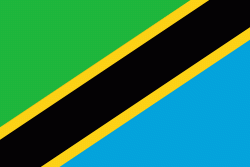Same District (Same)
Same is one of the seven districts of the Kilimanjaro Region of Tanzania. It is bordered to the north by the Mwanga District, to the northeast by Kenya, to the south and southeast by the Korogwe District and Lushoto District of Tanga Region, and to the west by Simanjiro District of Manyara Region. The district capital is the town of Same, Tanzania. The south Pare Mountains are located within the district's boundaries and so is a part of Mkomazi National Park. According to the 2002 Tanzania National Census, the population of the Same District was 212,235. The population had risen to 269,807 according to the 2012 Tanzania National Census.
The district covers an area of 6,221 km2, and has an average elevation of 1,034 m. The tallest point being Shengena Peak at 2, 463m. The district is home to Mkomazi National Park, and a few other protected areas such as Chome Forest Reserve which is home to the South Pare white-eye, an endemic bird found only the district.
The district covers an area of 6,221 km2, and has an average elevation of 1,034 m. The tallest point being Shengena Peak at 2, 463m. The district is home to Mkomazi National Park, and a few other protected areas such as Chome Forest Reserve which is home to the South Pare white-eye, an endemic bird found only the district.
Map - Same District (Same)
Map
Country - Tanzania
 |
 |
| Flag of Tanzania | |
Many important hominid fossils have been found in Tanzania, such as 6-million-year-old Pliocene hominid fossils. The genus Australopithecus ranged across Africa between 4 and 2 million years ago, and the oldest remains of the genus Homo are found near Lake Olduvai. Following the rise of Homo erectus 1.8 million years ago, humanity spread all over the Old World, and later in the New World and Australia under the species Homo sapiens. H. sapiens also overtook Africa and absorbed the older species of humanity. Later in the Stone and Bronze Age, prehistoric migrations into Tanzania included Southern Cushitic speakers who moved south from present-day Ethiopia; Eastern Cushitic people who moved into Tanzania from north of Lake Turkana about 2,000 and 4,000 years ago; and the Southern Nilotes, including the Datoog, who originated from the present-day South Sudan–Ethiopia border region between 2,900 and 2,400 years ago. These movements took place at about the same time as the settlement of the Mashariki Bantu from West Africa in the Lake Victoria and Lake Tanganyika areas. They subsequently migrated across the rest of Tanzania between 2,300 and 1,700 years ago.
Currency / Language
| ISO | Currency | Symbol | Significant figures |
|---|---|---|---|
| TZS | Tanzanian shilling | Sh | 2 |
| ISO | Language |
|---|---|
| AR | Arabic language |
| EN | English language |















